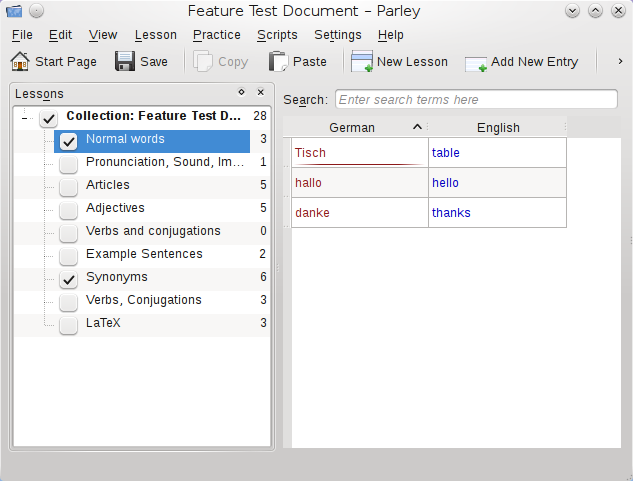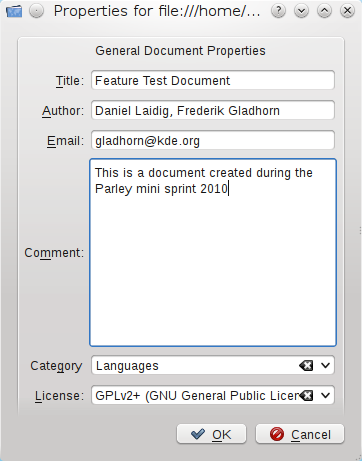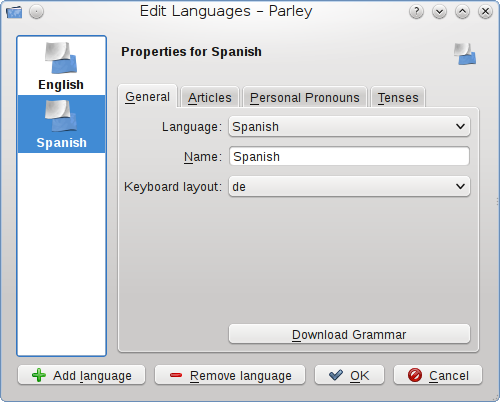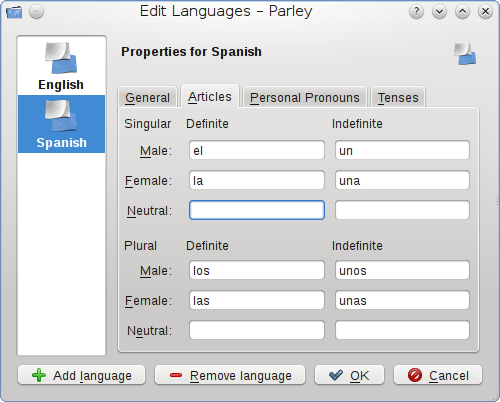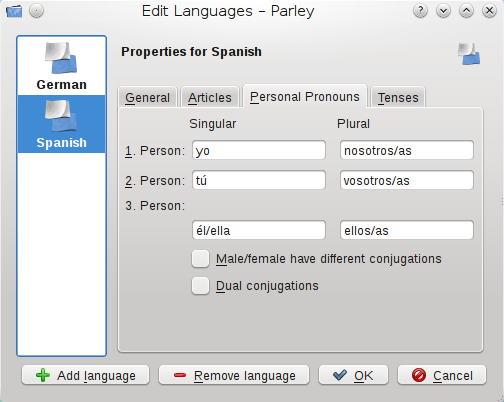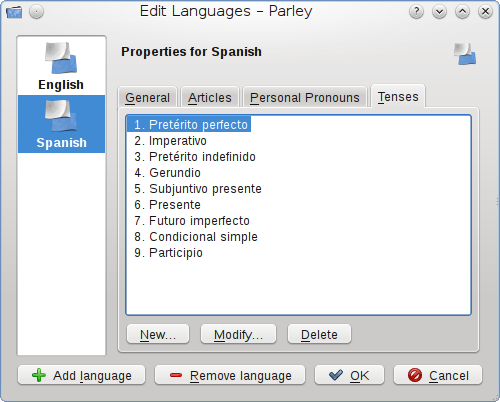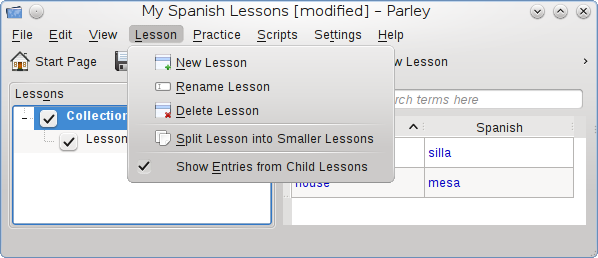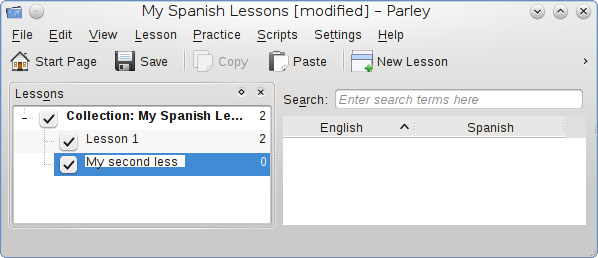Parley/Manual: Difference between revisions
SabineEller (talk | contribs) |
SabineEller (talk | contribs) |
||
| Line 371: | Line 371: | ||
===New Collection: Vocabulary English-German=== | ===New Collection: Vocabulary English-German=== | ||
In this section we describe how you can create a vocabulary training file including pictures and sound. In a second stage we will also add adjectives and verbs. | In this section we describe how you can create a vocabulary training file including pictures and sound. In a second stage we will also add adjectives and verbs. This is a very complete example and therefore quite long. Eventually you will not need all points for your project. | ||
Since we wish to add soundfiles and pictures, we | Since we wish to add soundfiles and pictures, we should make sure that these will all be in one folder which for convenience is being called ''eng-deu''. Our data file we create with Parley will be saved in the same folder. This will help a lot when you decide to share your work with others. | ||
So this is what we have in terms of soundfiles and pictures: | So this is what we have in terms of soundfiles and pictures: | ||
| Line 452: | Line 452: | ||
[[File:Parley_trainer_eng-deu_0-9-4_011.png|thumb|500px]] | [[File:Parley_trainer_eng-deu_0-9-4_011.png|thumb|500px]] | ||
Once we attributed all word types we first will care about the '''''Adjectives''''' and add the '''Comparison Forms''' to it. So let's move to the '''''Adjectives''''' lesson only. | |||
[[File:Parley_trainer_eng-deu_0-9-4_012.png|thumb|500px]] | |||
To show the '''Comparison Forms''' on the right hand side of the screen, select '''View''' in the menu bar and activate the '''Comparison Forms''' checkbox. | |||
[[File:Parley_trainer_eng-deu_0-9-4_013.png|thumb|500px]] | |||
So let's edit the '''''Comparison forms''''' by adding '''Comparative''' and '''Superlative''' to the single adjectives. First click on the adjective for which you wish to add the comparison forms, in our case '''''big''''' and add '''''bigger''''' and '''''biggest'''''. Then we simply pass on with the next adjective to complete until we have finished. | |||
[[File:Parley_trainer_eng-deu_0-9-4_014.png|thumb|500px]] | |||
Once you are done you can start to practice by clicking on the '''Practice''' button. | Once you are done you can start to practice by clicking on the '''Practice''' button. | ||
Revision as of 09:39, 2 June 2010
Template:I18n/Language Navigation Bar
Home >> Applications >> Education >> Parley >> Parley Manual
Parley Manual
This Manual is for Parley that comes with the KDE Software Compilation 4.5 and later. Especially the practice has changed since KDE SC 4.4.
Introduction
Parley is a vocabulary trainer. It helps you to memorize your vocabulary, for example when you are trying to learn a foreign language. You can create your own files with the words you need or select from a great variety of Vocabulary Files. There you can find files containing language vocabulary and also anatomy, music, geography, chemistry or exam preparation.
Parley is very flexible and uses the flash card learning approach. It automatically keeps track of your progress and lets you sort your vocabulary as you wish. But unlike real flash cards you can use different learning methods with Parley
Flashcards contain expressions on the front side and their translation on the back. You start with a pile of cards. If you know the translation on a card, you can put it into a second pile of cards. If you fail, you keep it in the first one to try again later.
Parley's main focus is not to teach you grammar or other sophisticated things. However, there are some exercise forms which may help you in this matter.
Tip: Like in all applications try to use the right-click if you explore features and functionality in Parley. The right-click displays a "context menu" that shows what you can do with your present situation. Try right-clicking a bit and have a look!
Start Page
When your first start Parley you are greeted by the start page. It shows you the last vocabulary collection that you worked with.
A vocabulary collection is a file that contains lessons and words to practice.
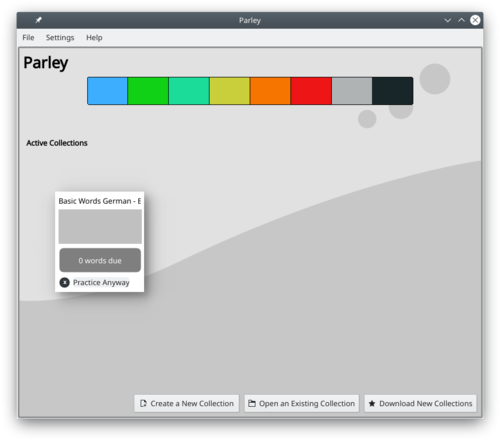
To edit a file, click "Edit" on the right of it. To start practising right away, use the Practice button.
If you'd like to start your own collection of vocabulary, click "Create a New Collection".
You can also open a collection if you have it on your computer already but it's not in the list, or download a collection.
Parley comes with themes, you can switch to a different graphical style in the settings. From the Start page you can select different themes by clicking on Settings in the menu bar and then Configure Parley. You can choose among the present themes or click on Get New Themes to install new ones from the online server.
Just two examples, the Bees and the Fluffy Bunny themes:
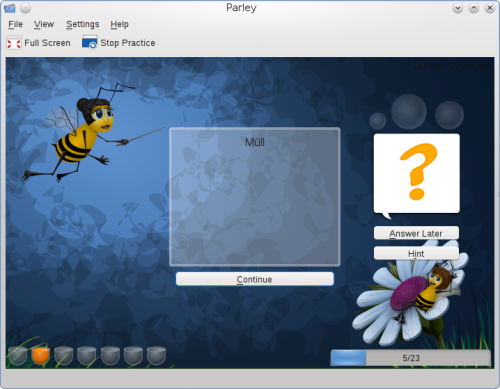
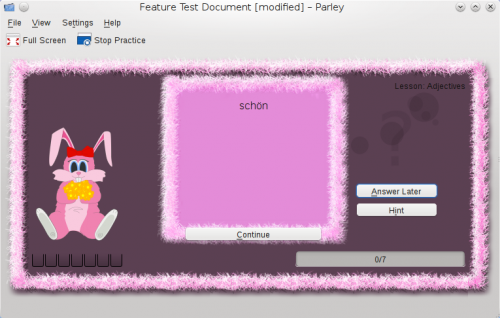
Open an existing file
Let's suppose your file is already on your hard disk.
This is how you will see your screen the first time you start Parley:
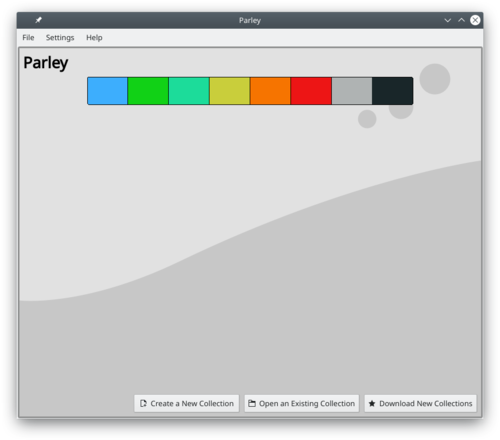
Click on the button Open an Existing Collection
In the file selection dialog navigate to the directory that contains the data file, select it by clicking on it. Depending on your system the file opens immediately or you have to click on ok
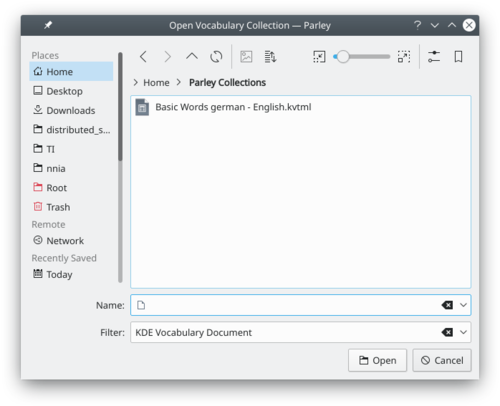
The file is loaded and you will see something similar to this:
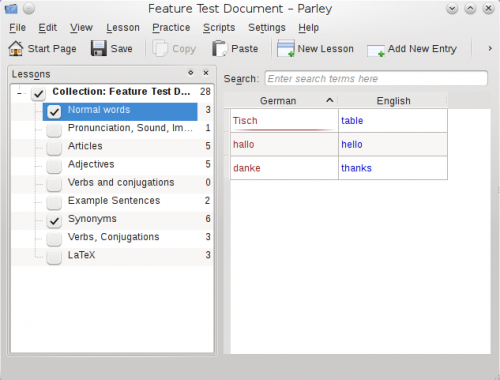
For the example file mentioned here we know that it contains pictures and sound. These are not immediately shown. Therefore the next step is to select the options for the visualization of pictures and sound files.
In the menu bar select view and activate picture and sound.

The next step for you is then how to practice vocabulary.
Vocabulary Practice
To start practising you select a document after starting Parley. When you have it opened in the editor, just click "Practice" in the toolbar.
Configure Practice
There are three areas in the practice configuration:
- The selection of languages
- The selection of the practice mode
- The selection of the lessons that also shows your current progress
You can also select which lessons you want to practice with the checkbox in front of the lesson name. The number of words that each lesson contains is shown next to its name. After that you see your current progress with this lesson.
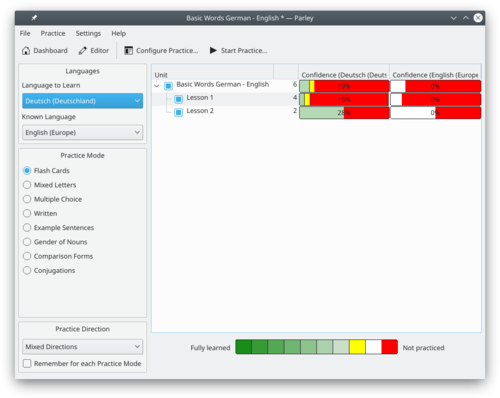
Blocking
If you plan to practice your vocabulary regularly, you should enable the blocking feature. It is in the menu in Practice→Configure Practice. There you select the blocking page and tick the checkbox that says Blocking. Now you can even configure the interval in which words that you answered correctly will be repeated.
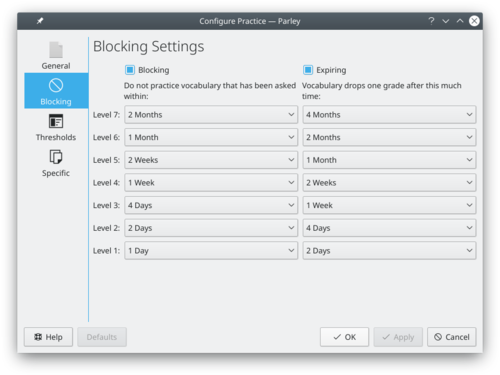
Thresholds are another way of limiting what you want to practice.
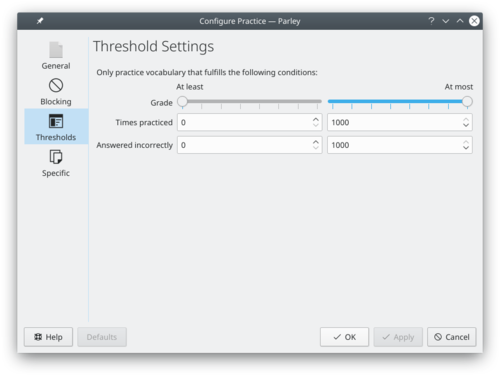
You can find several more configuration options for the practice in the advanced settings page.
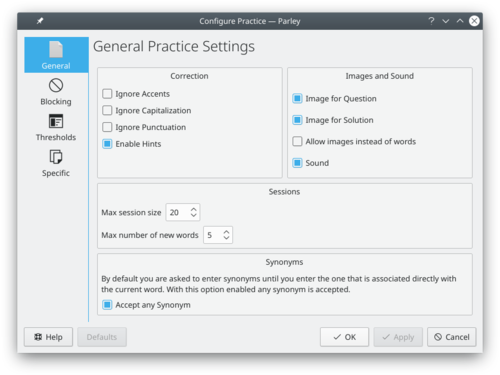
Practice
Flash Cards
After having activated the Flash Card Practice Mode and having clicked on Start Practice the following screen shows up. The Flash Card training mode works just as if you would do it with "real" flash cards. You imagine the the result and should you wish some help, you can click on Hint which will start to give you the result by showing one char for each click on Hint starting from the first and going ahead one by one to reach the last letter. Of course you can also decide to Answer Later by clicking on that button.
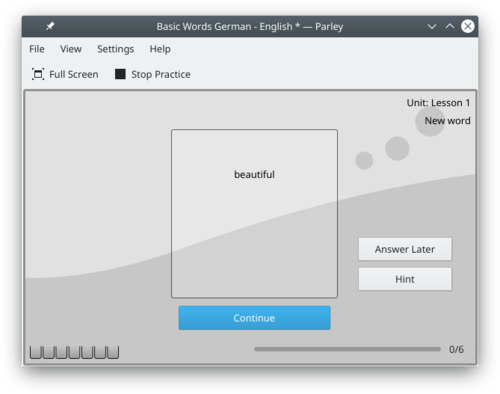
When clicking on Continue you are shown the correct answer. At this stage you then have to tell the software if you knew or did not know the solution by clicking either on I did not know it or I knew it. This will take you to the next question.
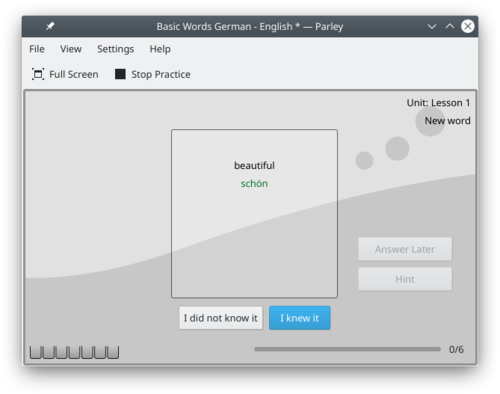
You can stop practicing anytime by clicking on Stop Practice.
Mixed Letters
Mixed letters is a training method that provides you with an immediate help: all letters that are part of the solution are shown mixed up:
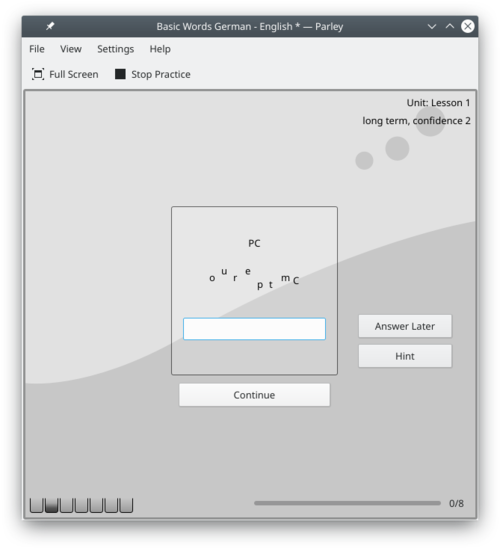
Should you wish some help, you can click on Hint which will start to give you the result by showing one char for each click on Hint starting from the first and going ahead one by one to reach the last letter. Of course you can also decide to Answer Later by clicking on that button.
To give the answer type in the correct answer in the blank field below the mixed letters and click on Continue.
If your answer was correct Parley will tell you so and you just can click on continue to go ahead with the next question.
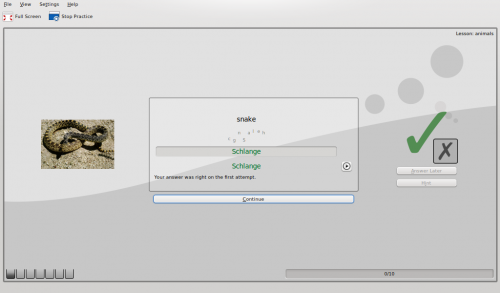
Should you enter a wrong answer, the first time you will be told to try again:
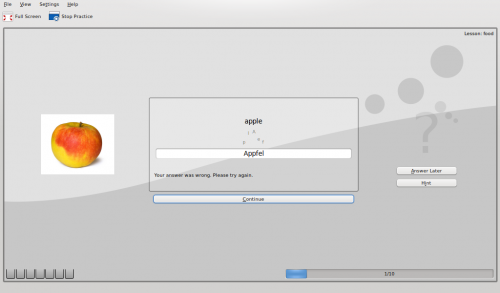
If your answer is wrong also the second time then the following comes up and you are shown the solution. Go ahead with Continue.
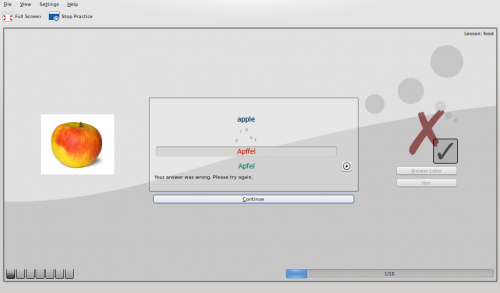
Multiple Choice
In Multiple Choice mode you are shown a number of potential answers, one of which is correct. By clicking on Hint Parley excludes one of the wrong answers so that your choice gets more and more restricted with each further click on Hint. Of course you may also choose to Answer Later.
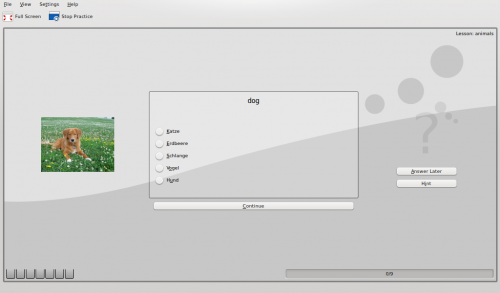
Once you made your choice by clicking on what you believe to be correct, Parley shows up with the screen below to tell you. Go ahead with the next question by clicking on Continue.
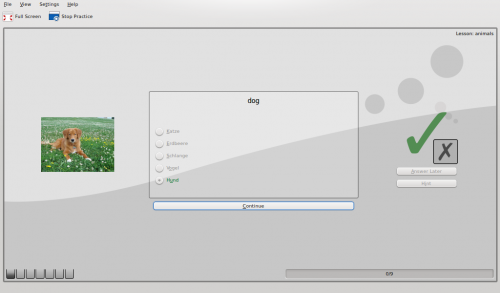
If your answer instead was wrong, you get something like the following. Also here you go ahead by clicking on Continue.

If you wish to stop practice, just click on the Stop Practice button.
Written
When you select the option Written to do your practice you are supposed to type in the solution. You can use the button Hint which will start to give you the result by showing one char for each click on Hint starting from the first and going ahead one by one to reach the last letter. Of course you can also decide to Answer Later by clicking on that button.
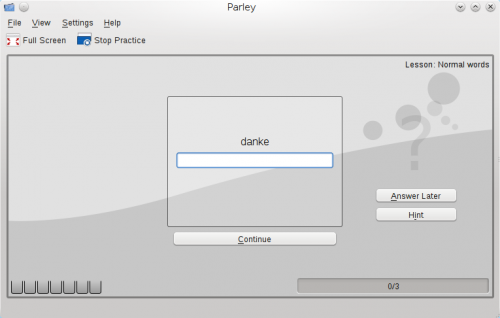
Once you inserted the solution click on Continue and Parley will show you that your answer was correct. Go ahead by clicking on Continue again.
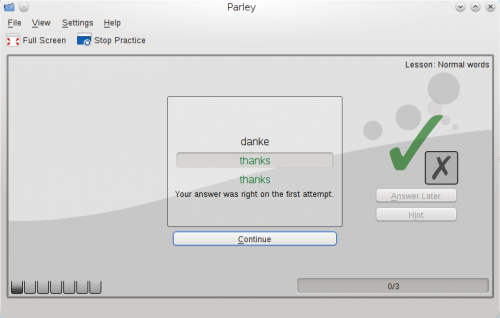
Should you give a wrong answer, you may re-try to insert the correct answer several times. Only if all tentatives are wrong something like the following will show up.
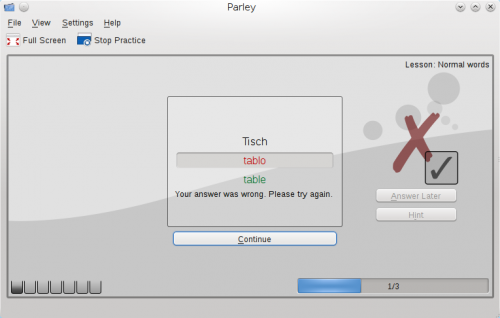
Go ahead practicing by clicking on Continue or stop by clicking on the button Stop Practice.
Summary After Practice
The summary shows up when you finish a learning session. It shows in a big bar, how well you did.
Below it you see in a table all the words that you practiced and the mistakes that you made. You can even sort this table by clicking on the column headers. That is especially helpful if you want to know which words you need to practice most. Click the wrong attempts column for that.
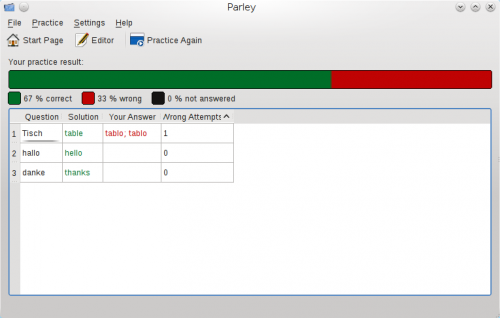
Grammar Practice Modes
With Parley you can also learn specific grammar structures, such as the gender of nouns, the comparison forms of adjectives and the conjugation of verbs. Let's look at some examples.
Articles and Gender of Nouns
Once the practice mode Gender of Nouns is activated, click on Start Practice. In the case below we use German as language to learn and so you have three genders to choose from: masculine, feminine and neuter. By clicking on Hint one of the wrong answers gets excluded. Of course you can also decide to Answer Later by clicking on that button.
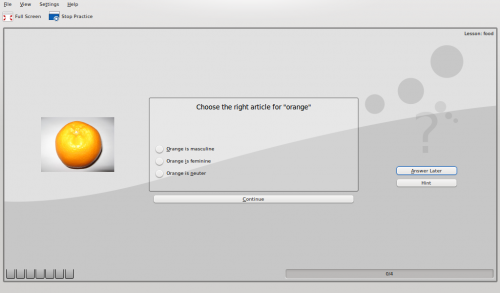
When you give the correct answer the following is shown and you go ahead practicing by clicking on Continue.
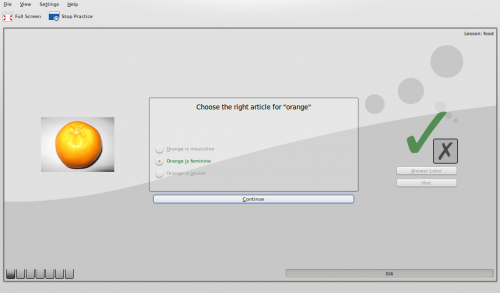
Should you give the wrong answer the following is shown and you go ahead practicing by clicking on Continue.
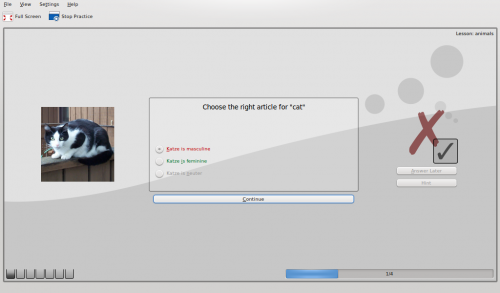
You can stop practicing anytime by clicking on Stop Practice.
Comparison Forms of Adjectives
Conjugations
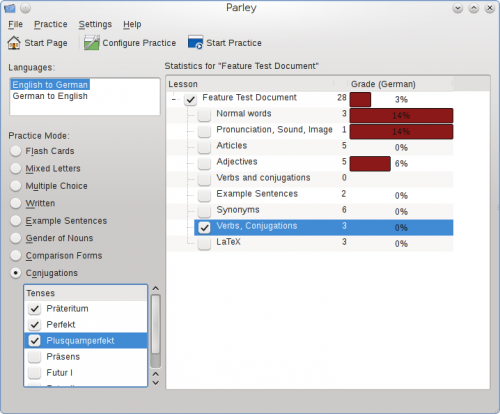
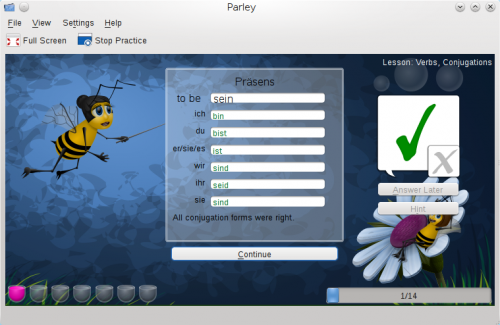
Vocabulary Editing
Setup
Before you start using a vocabulary collection or create your own it is helpful to understand the different elements in Parley and configure them accordingly. The next sections will guide you step by step through this process. There are several locations in Parley for settings:
- File→Properties This is the place for the "General Document Properties", meaning some information about your vocabulary collection and yourself.
- Edit→Languages Find here settings around the languages you use
- Practice→Configure Practice Here are settings how you practice your vocabulary. Depending on what you want to do in the moment you change them on the fly.
- Settings→Configure Parley For more general and display settings
About the Collection
Entering meta data like a title and your contact info if you plan on giving your collection to other people. Use File->Properties to edit the data.
Languages and Grammar
Set up some grammar details to let Parley help you. Use Edit->languages to pull up the grammar dialog.
Articles in English are simply the which is the definite article and a as indefinite article. Most other languages have more articles which can be filled in at the articles tab.
For conjugations the personal pronouns should be filled out. Most languages do not have different conjugation forms for he/she/it, in that case, you should not check Male/Female have different conjugations! Simply enter the pronouns for all three forms. Personal Pronouns in English:
| Singular | Plural | |
| 1st Person | I | we |
| 2nd Person | you | you |
| 3rd Person | he/she/it | they |
Tenses: Depending on the language, you can enter the right tenses which you later want to learn how to conjugate. Examples are: Simple Present, Simple Past, Future I etc.
Let's have a closer look at Spanish
On the General tab the basic language settings, like here
- Language = Spanish
- Name = Spanish
- Keyboard layout = de (for German)
You can leave Keyboard layout empty if you are not sure about what you are using. Parley will then simply take the standard layout of your computer.
Let's have a look at the Articles tab: Spanish knows only male and female nouns, therefore the field Neutral remains empty.
Spanish Personal Pronouns have multiple forms for 3rd person singular and 1st, 2nd and 3rd person plural. To remain consistent, the possibilities should be entered with a / between the two forms.
Under Tenses you will find the various tenses that are available for a verbform. You can add to the teneses that are already there by clicking on New, modify with Modify or in case something does not actually exist simply Delete the tense after having it selected.
Lessons
On the left you have a list of lessons. If you started a new collection, this list might be empty except for one lesson that was created by default for you.
If you cannot see the list of lessons, you might have to enable it in the View menu - View->Lessons.
The check boxes in front of the lesson name show which lessons are currently included in your practice. The number next to it, is the number of words in the lesson.
New Lesson
Add a new lesson: Select where this lesson belongs to, for example the collection My Spanish Lessons.
In the Lesson menu, select New Lesson.
Please make sure to select the right point in the tree structure of lessons before selecting New Lesson. In our case, wanting a Sub-Lesson of Collection: My Spanish Lesson it is exactly that one that needs to be selected before going ahead with New Lesson.
Moving, Renaming and Deleting Lessons
To change the name of a lesson, double click it, or right click on the lesson and choose "rename". You can also delete it this way (but you'll loose its contents also then).
If you don't like the arrangement of lessons, you can move a lesson with the mouse. You can drag it onto another lesson, then it will become a child of that lesson.
Splitting a lesson
If your lessons grow too big, you can choose to split them up to make learning easier in small units. 20 words for a lesson is probably a good size. Right click a lesson, or use Lesson->Split and the lesson will be separated into child lessons. You can choose to randomize the words that are put into the new lessons before assigning them, or to keep them in order.
What is Shown in the Table
Parley shows always the words of the lesson that you have currently selected. You can enable to see the words in sub-lessons contained in this lesson also. Use Lesson→Show Entries from Child Lessons to enable this. That way, you can browse all words by selecting the document lesson at the very top.
Word Types
Parley lets you associate word types with the words. Word types are for example: Nouns, Verbs, Adjectives and Adverbs.
In order to work with word types, enable the word type tool: View→Word Types
You can categorize the word types just like lessons.
If you want to see all words of a certain type - e.g. all nouns, simply select the noun category, and you will see only nouns in the table.
The easiest way to set the word type, is to drag and drop a word onto its type. You can even do this with multiple words at the same time.
Words or Sentences
Finally the real vocabulary comes here :D
Adding New Vocabulary
Use "Add New Entry" in the toolbar to add new words. You can start typing the word in the first language right away. By default Parley lets you enter another word when you press enter in the last row, so you don't have to keep using the add button. After entering the first word, press enter or tab to go to the next language.
Editing Words
If you want to replace a word, select its entry and start typing. To change the word instead, double click the entry and you can change the contents of the cell without losing the old word.
Press TAB to go to the next word. Enter leaves the editing mode. You can use the arrow keys to move around.
Synonyms
Synonyms are hard to set up and do not always work really well. Here is how you set them up in any case:
- Use View→Synonyms to see the synonyms tool.
- Select first word (A) you want to make synonyms, then click on the second word (B)
- The button in the synonym tool changes it's text to "A and B are synonyms"
The words will now be shown as connected in the synonym tool and can be recognized as synonyms in the practice.
Adding Images
First show the sound tool by selecting View in the menu bar and then clicking on Image. The checkbox in front of Image will then be activated. This will show up the picture section on the right hand side of the Parley screen
To add an image to a word make sure the word is highlighted. In the image section on the right hand side click on the Folder icon and choose the picture you wish to associate.
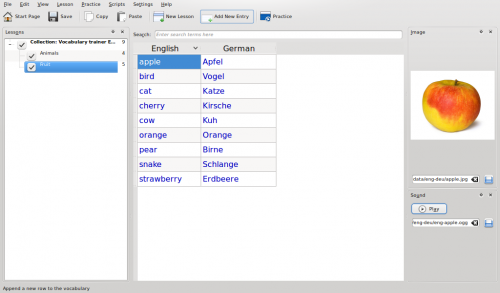
Adding Sound
First show the sound tool by selecting View in the menu bar and then clicking on Sound. This will show up the sound section on the right hand side of the Parley screen.
To add a sound to a word make sure the word is highlighted. In the sound section on the right hand side click on the Folder icon and choose the sound you wish to associate.

Creating new files
In this section we will describe how to create new files and this not only with the usual vocabulary learning part, but also for grammar exercises, mathematics etc.
New Collection: Vocabulary English-German
In this section we describe how you can create a vocabulary training file including pictures and sound. In a second stage we will also add adjectives and verbs. This is a very complete example and therefore quite long. Eventually you will not need all points for your project.
Since we wish to add soundfiles and pictures, we should make sure that these will all be in one folder which for convenience is being called eng-deu. Our data file we create with Parley will be saved in the same folder. This will help a lot when you decide to share your work with others.
So this is what we have in terms of soundfiles and pictures:
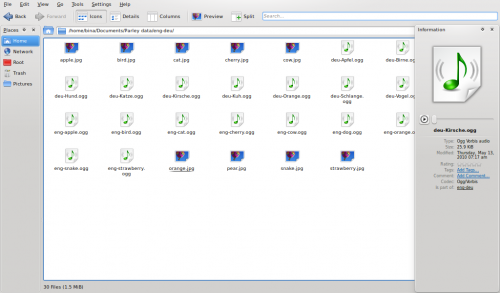
Let's start from the welcome screen which is shown once you launch Parley:

Click on the button Create a New Collection
The General Document Properties page shows up which is being filled as follows (just adapt to what your file is about):
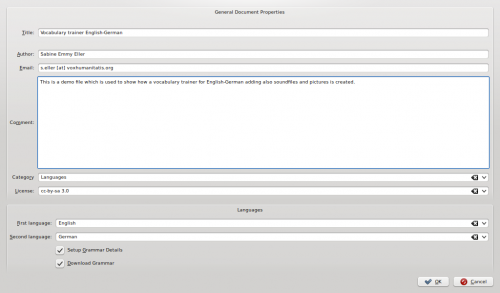
Just click on OK. The following screen asks you for the Properties for English. Here we don't want to change anything and therefore we just click on OK.
As a first step, let's just create the vocabulary part. We will think about the addition of the soundfiles and pictures in a second stage. So this is how the Vocabulary trainer file looks like:
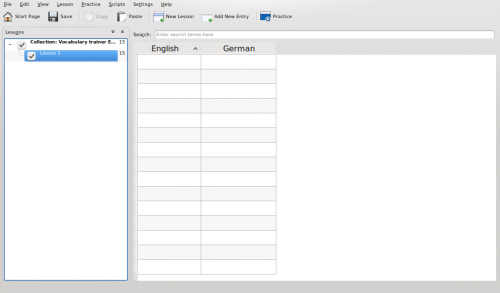
Before we do anything else, let's save the file to the folder with the pictures and soundfiles. Just click on the Save-icon and select the folder using the navigation. In this example we will call the file Trainer eng-deu - once you entered the name just click on save.
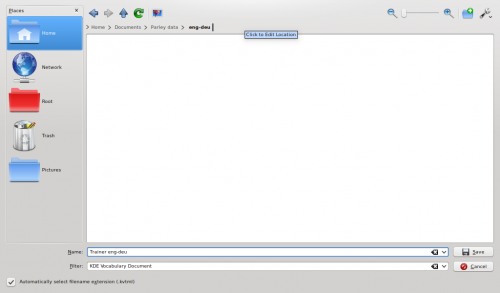
If you now check your folder where the soundfiles and pictures are, you will also find the file Trainer eng-deu.kvtml
Let's have a short look at the words we want to add: apple, bird, cat, cherry, cow, orange, pear, snake, strawberry. We have animals and fruit and therefore we decide to create two lessons that are called: animals and fruit.
We now change Lesson 1 to Animals and then will add a lesson called Fruit. Right-click on Lesson 1 and choose Rename Lesson from the options shown. Now Lesson 1 is highlighted and you can simply overwrite it by typing in Animals. When done, just hit the return button. Now right-click on Collection: Vocabulary trainer E... which is the root of the lesson tree and choose New Lesson from the options shown. In the new field write Fruit and hit the return button.
Let's insert first the animals. Please click on the lesson Animals and you will get the empty table you can fill in. Just a first click with your mouse in the first field, insert the source terms in the first column and the target terms in the second column. Once you inserted all 4 English animal names with their German translation the screen looks like this:
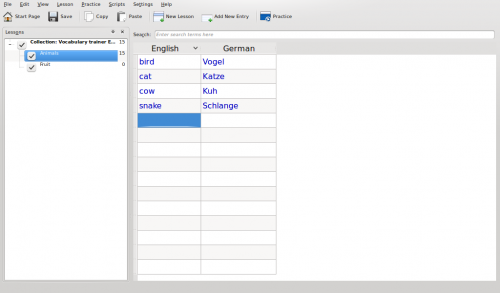
Having only 4 entries there are quite some empty lines which should be deleted. To do this there are two possibilities: click on the first empty field, keep the shift key pressed and click on the last empty field to delete. All lines to be deleted will be highlighted. The press the Del key and confirm the question Do you really want to delete the selected entries? by clicking on the Delete button.
Let's add the fruit terminology. Just click on the lesson named Fruit. This second lesson is completely empty. Since we have five fruit terms we need to add five lines. Just press the Ins key five times and then, just like before we add our terminology.
Don't forget to save every now and then ...
A click on the root of our lesson tree Collection: Vocabulary trainer E... and Parley will show us all entries that are present in the two lessons:
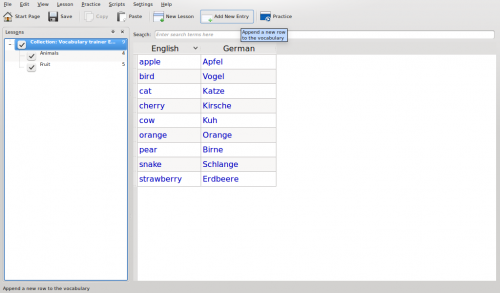
Time to add sound and images. First of all we need to activate the view for Image and Sound. From the menu bar select View and there click on Image and then Sound. Once these options are activated you get two new sections on the right hand side of the Parley editing screen: Image and Sound.
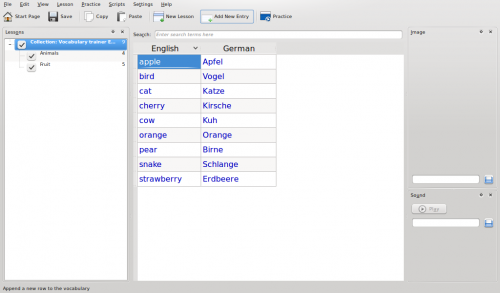
Well apple is highlighted, so let's add the picture. In the image section on the right hand side click on the Folder icon and choose the picture you wish to associate.
To add the pronunciation of apple, just do the same in the Sound section, selecting the relevant sound file.
And that's what the screen then looks like:

By clicking on the Play button you can listen to the pronunciation.
Then click on Apfel highlighting the field. Like you will note the picture with the apple is associated also to the German term. In the sound section select the pronunciation, just like before.
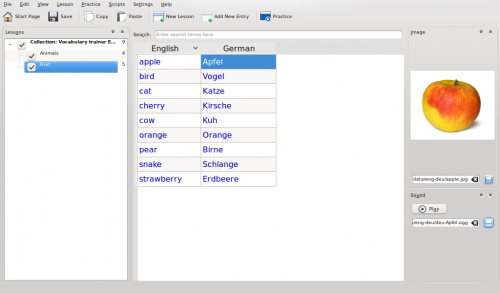
Just go ahead like this for all terms.
Time to add adjectives and verbs as lessons to our project. So just do as before with the lesson fruit and create two new lessons: adjectives and verbs. Let's assume we will add big, small, old, jung, narrow' in the adjective lesson and to go, to come, to buy, to drink, to eat in the verb lesson.
The following shows a screenshot with all inserted terminology. Now words are mixed and it would be nice to see what is a noun, adjective or verb.
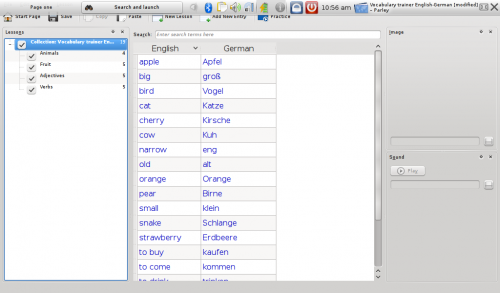
As next step we are going to show up the Word Type. Select View in the menu bar and then select Vocabulary Columns. We activate Word Type for English and German by clicking on the checkbox in front of Word Type. Then click on OK to accept the changes.
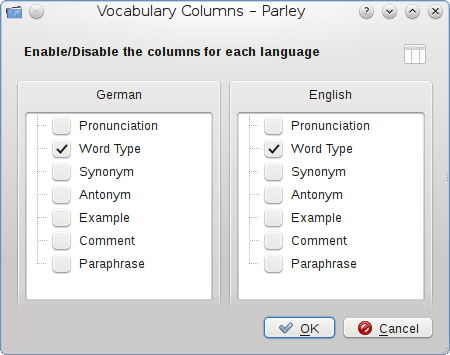
By clicking on the fields in the column Word Type you can select the word type and for those languages where nouns have a gender you can also select the Noun/Gender combination. Below the Word Type column with part of the selections already done.
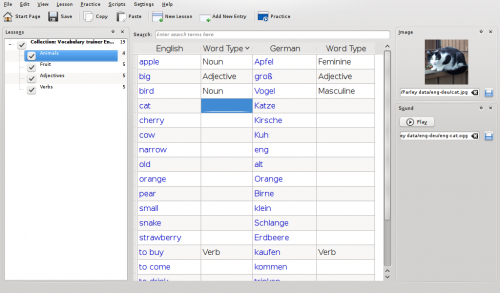
Once we attributed all word types we first will care about the Adjectives and add the Comparison Forms to it. So let's move to the Adjectives lesson only.
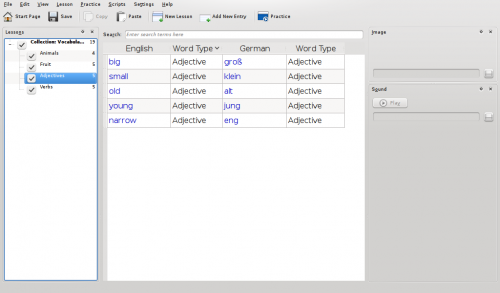
To show the Comparison Forms on the right hand side of the screen, select View in the menu bar and activate the Comparison Forms checkbox.
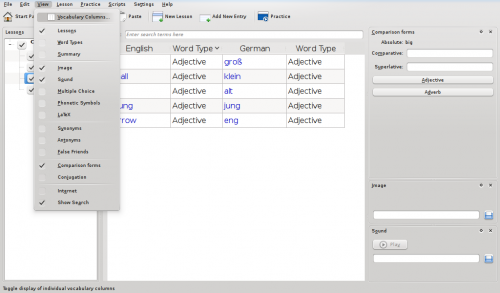
So let's edit the Comparison forms by adding Comparative and Superlative to the single adjectives. First click on the adjective for which you wish to add the comparison forms, in our case big and add bigger and biggest. Then we simply pass on with the next adjective to complete until we have finished.
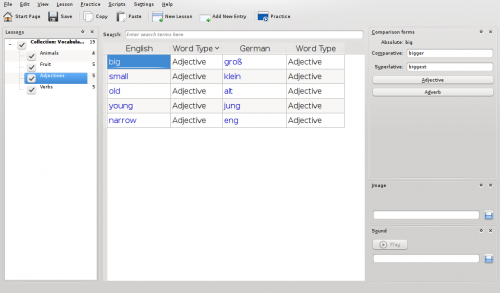
Once you are done you can start to practice by clicking on the Practice button.
New Collection: Single names and collective names
This exercise was created for the 3rd class of an Italian primary school. Pupils are supposed to connect single names with collective names, such as tree --> woods
When you start Parley you get the start page, eventually also listing some previously used files (that you cannot see here).

Click on Create a New Collection and the following screen with empty or partly filled fields will show up:
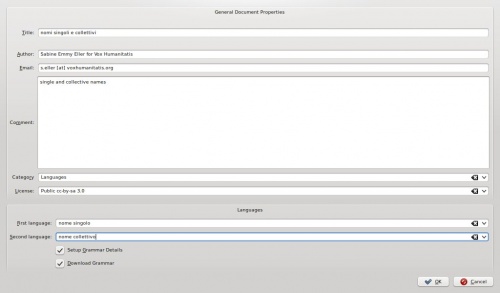
Fill in the title, here nomi singoli e collettivi, your name, e-mail address, in the Comment section you can write down a more detailed description, select your category and license. Then there we have something special: instead of indicating the first and second language, like it normally would happen, we added nome singolo (single name) and nome collettivo (collective name). Setup Grammar Details and Download Grammar are not needed here. In the screenshot they are still activated - please deactivate them by just clicking on the checkboxes. When you are done, please click on OK.
The Properties page for nome singolo comes up and here you see it already with the necessary changes made:
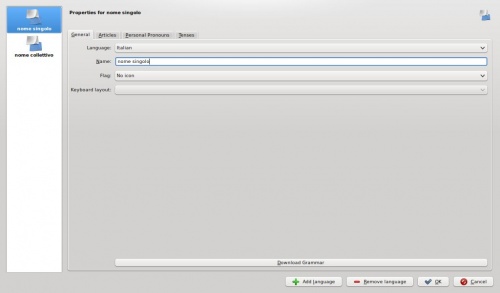
On the left hand side you can see where the data you are adding belongs to. nome singolo. Choose the language, here Italian and insert nome singolo in the following editable field. Then click on OK.
Now the Properties page for nome collettivo is shown:
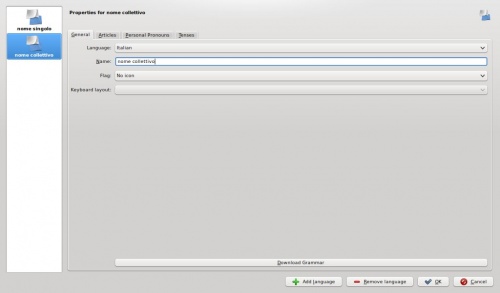
Like before: choose Italian as language and insert nome collettivo and click on OK.
And now you can start to edit:
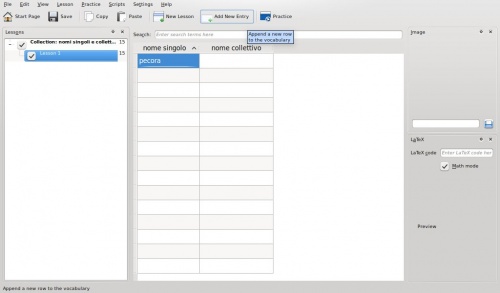
Just insert the nome singolo (single name) in the first column and the corresponding nome collettivo (collective name) in the second column.
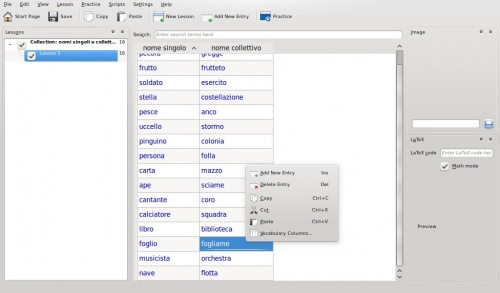
If the number of available fields is not enough, just right-click anywhere on the edit section and choose Add New Entry. Don't forget to save your file every now and then. When you have finished adding all entries you will want to see if Practice mode works fine. Well just click on the Practice button right above the edit section and the page with the practice settings comes up:
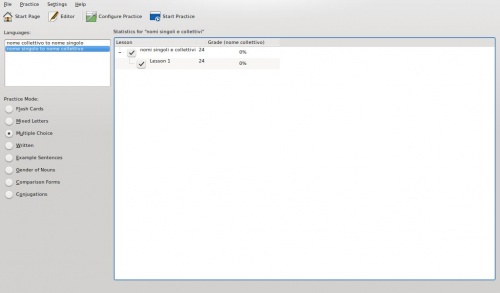
In this case Multiple Choice is a good option, but also Written will do fine. After choosing the Practice Mode just click on Start Practice and have fun.
Using Parley for Exam Preparation
- what to bear in mind with long questions / answers?
- how to start with a new Exam
- example 1 with capitols
- example 2 with sentence
More Advanced Crazy Stuff
File formats, Uploading files, Scripting

